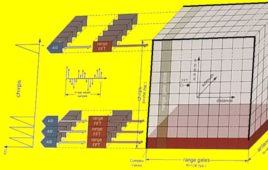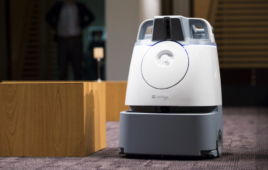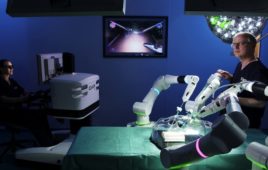RoboScreens, a graphical screen mounted to the arm of an ABB articulated arm robot that creates a unique viewer experience by bringing virtually unlimited 6-axis movement to the video media, gained prominence in 2010 when a group of large model RoboScreens travelled the globe as main stage props for the Bon Jovi Circle Tour. The screens moved to the beat of the music, displayed real time video and pre-produced animations, and assembled them into various formations such as individual stairs and an elevated performance platform.
Since that experience, ABB Robotics collaborated with Andy Flessas (also known as andyRobot and who owns numerous patents on RoboScreen) of Las Vegas to develop the RoboScreen® function packages.
In addition to five robot and screen size options, the function packages include a selection of specially developed control software and can include a custom mixing board to interface between the software and the RoboScreen.

“RoboScreens help extend the language of animation, providing the life juice to choreograph personality, expression and action into a broad horizon of new applications,” said Flessas. “In live entertainment applications the RoboScreens and Robot Animator® software will create coordinated visual interaction with both the performers and audience. In advertising and hospitality applications it will create new ways to interface with customers and to introduce simulated motion into on-location messaging, televised sporting events and video games.”
The RoboScreens will be available in a range of sizes from diagonal screen dimensions of approximately 26 in. to 13.5 ft, and feature robot models from the IRB 120, ABB’s smallest 6-axis robot, to the IRB 7600, ABB’s largest model. Custom RoboScreens will also be available.
Integral to the function packages are two Autodesk Maya-based plug-ins to ABB’s mainstream RobotStudio software, co-developed by Flessas and the ABB global software team. The Robot Animator PowerPac for RobotStudio can control standard ABB Robots, and the RoboScreen PowerPac is specifically applicable to RoboScreens. RobotStudio is ABB’s simulation and offline programming software, and Maya is a 3D computer graphics software used to create interactive applications, including video games, animated film and visual effects.

With the PowerPac plug-ins the software merges the features and benefits of a graphic simulation tool with application programming software, creating a fully simulated robotic motion program that can be downloaded directly to robot system to control the robots. Quite simply, what is simulated in the program is what the robots do on the floor.
A custom designed mixing board similar to those used in live concert and stage productions will be available as an option to the function packages. The system will merge with a Core Interface Module, creating a paradigm shift in the control and programming of robots in entertainment applications. The mixing board will allow entertainment industry personnel to control robots with equipment in which they are familiar, without needing formal robot programming experience; providing an integrated means to intuitively synchronize the robots with other stage or set elements such as lighting, sound, camera control and the movement of other props.
With the various robot and screen size options, the two dedicated software plug-ins and the mixing board option, a RoboScreen function package can be assembled to serve a nearly unlimited range of entertainment and commercial applications, which include:
- Live Events and Entertainment – RoboScreens positioned outside performance venues for pre-event entertainment or marketing, or positioned inside to provide replays and other event enhancements. Or as on the Bon Jovi tour or in a theatrical performance, the RoboScreens can also be an integral part of the production itself, providing an inimitable blend of 6-axis motion and video display for stage props, structural elements and visual intrigue.
- Retail Robotics – Strategically placed RoboScreens for interactive point-of-purchase advertising and in-store information to shoppers, providing advice for specific products and possibly allowing manufacturers to interact in real time with customers considering their product.
- Kinetic Architecture – RoboScreens as a moveable wall or floor, where the ambiance of a room can be altered by the motion of the screens and the video being played therein.
- Nightclubs and Sports Bars – RoboScreens that capture components of simulation technology with motion coordinated in real time to action occurring on screen during a performance, sporting event or video game.
ABB
www.abb.com
Filed Under: The Robot Report





Tell Us What You Think!